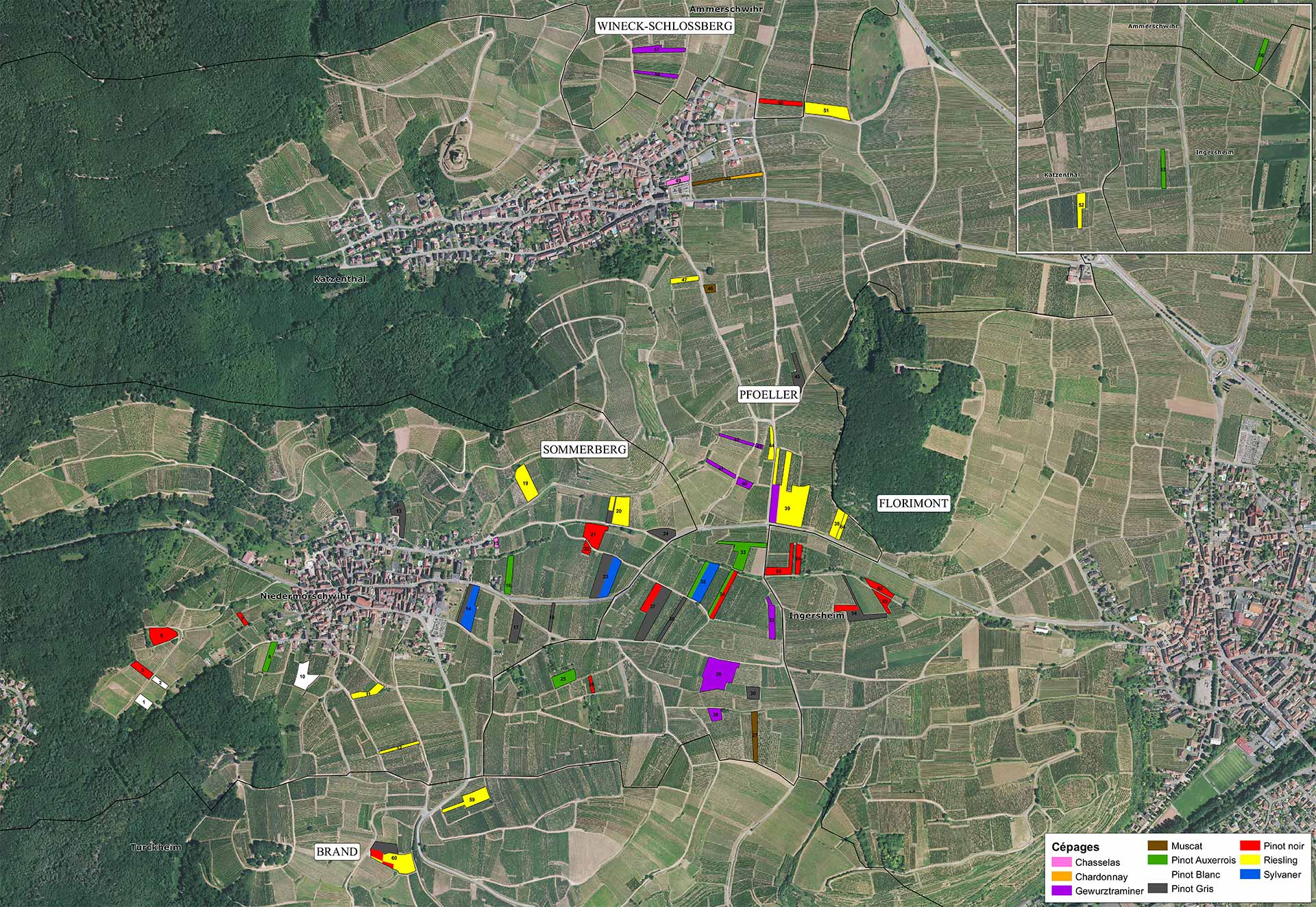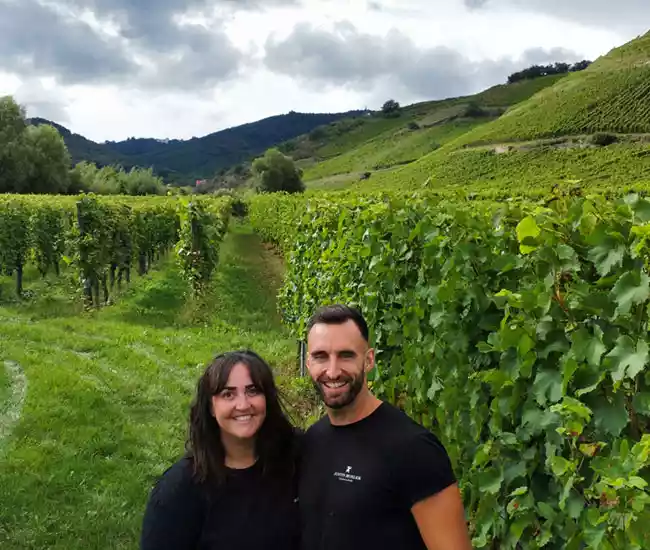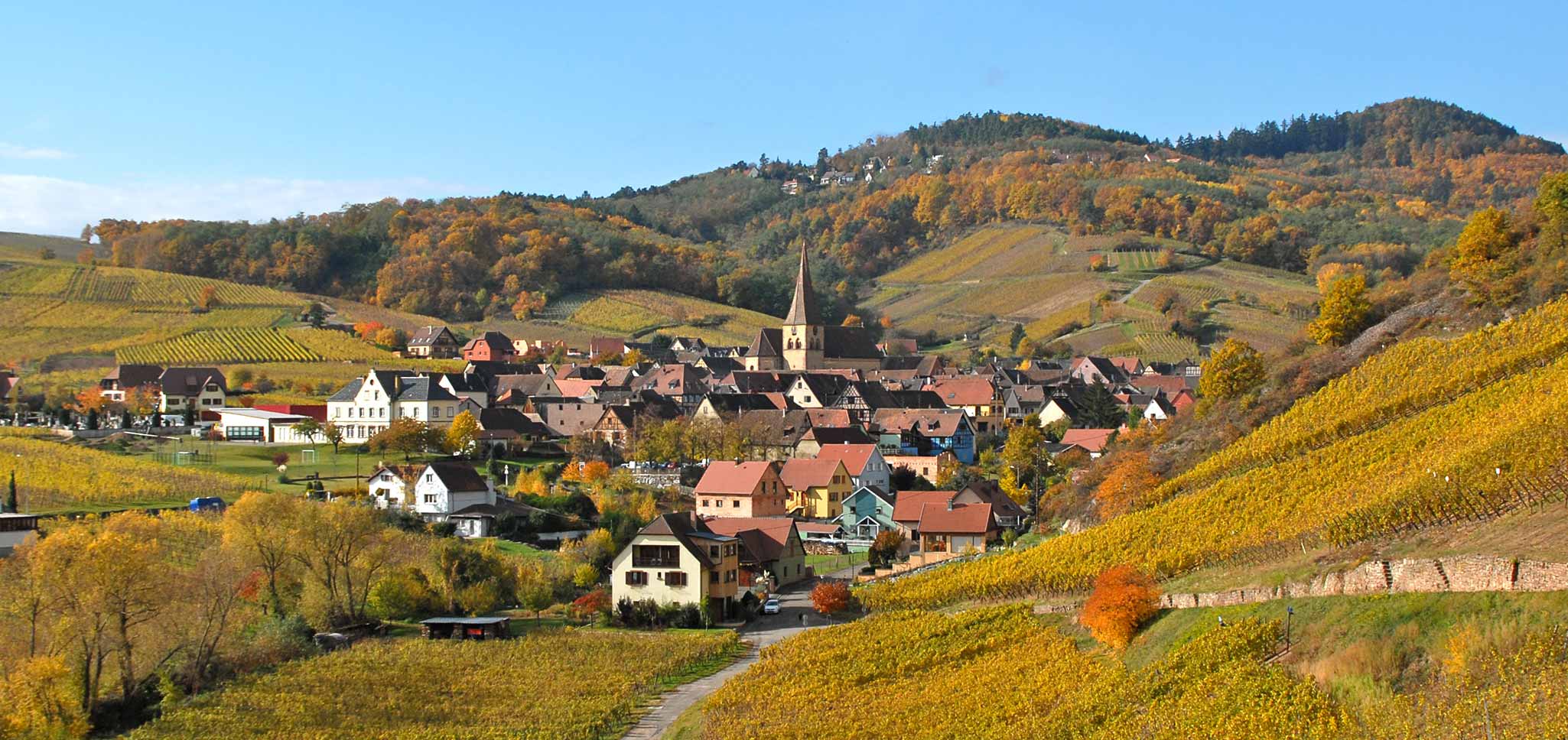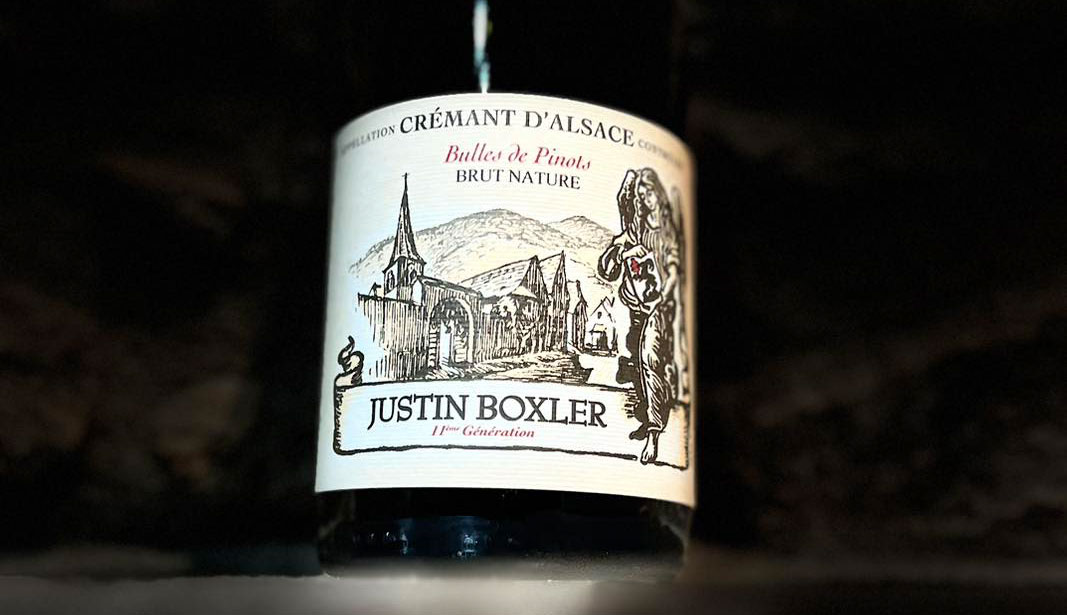Vins d'Alsace Home » The domain
Since 1672, the Justin BOXLER family wine estate has been located in Niedermorschwihr, in the heart of the prestigious Alsace Wine Route, a stone’s throw from Colmar.
The vineyard now covers 11 hectares, spread across five communes. Committed to an environmentally friendly approach for over fifteen years, the estate has naturally evolved towards organic farming, in strict compliance with its specifications. This approach has resulted in AB certification starting with the 2022 vintage.
Charlotte and Florent, representatives of the new generation, are producing the first officially certified organic vintages, continuing family know-how passed down with passion.
The estate’s vineyard extends over 80 separate plots, spread over 5 communal plots within an 8-kilometer radius around the property and the cellar.
The distribution of cultivated areas is as follows :
5 hectares in Katzenthal,
3.70 hectares in Niedermorschwihr,
1 hectare in Ingersheim,
0.80 hectares in Turckheim,
0.60 hectares in Ammerschwihr.
Niedermorschwihr, one of the smallest wine-growing areas in Alsace, allows for only limited cultivation. The majority of the estate’s vines are therefore concentrated in the neighboring village of Katzenthal. This terroir is also of particular importance: Katzenthal is the historic birthplace of a branch of the Boxler family, deeply rooted in this land.


Since the 1980 vintage, Anne and Pierre, descendants of Justin, have vinified the estate’s wines with passion, accompanying its evolution and transformations over the decades.
Today, they are passing the baton to the 11th generation, represented by Charlotte and Florent, driven by promising youth and carrying new ambitions. Both now assume the responsibility of creating the wines of tomorrow, respecting family know-how and with an eye toward the future.
The first guidelines focus on modernizing certain technical routes and exploring new commercial horizons, in line with current challenges in the wine world.
Having arrived at the estate in 2015, after several experiences with various Alsatian winegrowers, Florent uses his technical mastery and his passion to support the estate’s transition to certified organic viticulture. In particular, he oversees the fine management of the soil : mechanical work, planting plant covers, controlling competition with weeds. His approach aims to create a natural and sustainable balance in the vines, with the objective of healthy, resilient plants, and as little susceptible as possible to disease. A viticulture of observation, demanding, respectful of soil life and natural cycles.
Charlotte, for her part, enriched her vision of wine through experiences in the vineyards of Burgundy, Tours, and Germany. Returning to Alsace, she is fully involved in managing the vineyard, ensuring all aspects of cultivation, with rigorous manual work, in close connection with the living world. She also manages the estate’s communications and develops relationships with professional clients, actively contributing to the promotion of Justin BOXLER wines in France and abroad.
The village was known as Morswilre from 1148, a name appearing in a papal bull. Later, in the 16th century, the town was renamed Niedermorschwihr in order to distinguish it from Obermorschwihr which is near Eguisheim.
It belonged half to the Empire and half to the Habsburgs.
New plantations will enrich the heritage, while the development of new vintages and more daring vinifications will mark a new stage in the expression of the terroirs.
Work in the cellar, as in the vineyard, will tend towards ever greater precision and sobriety, with fewer inputs, while respecting the grape and its origin. A future where every action will count, for ever more unique, sincere, and vibrant wines.

Listening to the Terroir
Niedermorschwihr est situé à l’ouest de Colmar, près de Turckheim, sur la route des Vins d’Alsace.
Le village est connu sous le nom de Morswilre dès 1148, nom apparu dans une bulle du pape. Plus tard, au XVIe siècle, la commune est renommée Niedermorschwihr afin de pouvoir la distinguer d’Obermorschwihr qui se trouve près d’Eguisheim. Elle appartenait pour moitié à l’Empire et pour moitié aux Habsbourg.
À cheval sur les bans d’Ammerschwihr, de Niedermorschwihr et de Turckheim se trouve la station climatique des Trois-Épis, abritant entre autres un centre d’altitude et de cure de repos. Autrefois ville du « Grand Hôtel », qui accueillait les touristes et autres curieux, la station perd peu à peu sa popularité et sombre dans l’oubli.
Les Trois-Épis sont nés d’un pèlerinage dédié à la Vierge et fondé en 1491 : en effet, la Vierge y serait apparue à un forgeron d’Orbey, tenant d’une main trois épis de blé, de l’autre un grêlon (augure d’une bonne ou d’une mauvaise récolte selon que les gens se convertiraient ou non). Le pèlerinage reprit rapidement, après avoir été interrompu par la guerre de Trente Ans. Un prieuré fondé en 1651 fut supprimé à la Révolution. Le pèlerinage cependant existe toujours.
Niedermorschwihr is located west of Colmar, near Turckheim, on the Alsace Wine Route.
The village was known as Morswilre from 1148, a name appearing in a papal bull. Later, in the 16th century, the town was renamed Niedermorschwihr in order to distinguish it from Obermorschwihr which is near Eguisheim. It belonged half to the Empire and half to the Habsburgs.
Straddling the banks of Ammerschwihr, Niedermorschwihr and Turckheim is the health resort of Trois-Épis, which houses, among other things, an altitude and rest cure centre. Formerly the city of the “Grand Hotel”, which welcomed tourists and other curious people, the resort is gradually losing its popularity and sinking into oblivion.
The Trois-Épis were born from a pilgrimage dedicated to the Virgin and founded in 1491: indeed, the Virgin would have appeared there to a blacksmith fromOrbey, holding three ears of wheat in one hand, a hailstone in the other (augurs a good or bad harvest depending on whether people convert or not). The pilgrimage resumed quickly, after having been interrupted by the Thirty Years’ War. A priory founded in 1651 was abolished during the Revolution. However, the pilgrimage still exists.
The Brand is located at the exit of the Munster valley, overlooking the town of Turckheim, this locality enjoys remarkable sunshine thanks to its southern and south-eastern exposure. it rises to an altitude of 380 m.
Resting on a granite substrate called Turckheim, with two micas, altered in arena, it offers a sandy and coarse soil.
The very homogeneous granitic nature and the excellent exposure of the terroir greatly favor the Riesling, the Pinot Gris and the Gewurztraminer, which here cover 57.95 ha.
On this “Tierra del Fuego” where legend has it that the sun fought a dragon, the famous wines of Turckheim, and the Brand in mind, have enjoyed an undisputed reputation since the Middle Ages. And if the dragon was forced to withdraw into a dark cave, the Brand shone throughout history in the firmament of the Grands Crus of Alsace. With great finesse, subtle, very particular fruitiness, the wines of the Grand Cru brand present a royal balance.
The Sommerberg extends at the foot of Trois-Epis, south of Katzenthal and north of Niedermorschwihr. Located on a very steep slope (45°), this locality faces south and rises to an altitude of nearly 400 m.
The granitic substrate with two micas, called Turckheim, in a very advanced state of disintegration, gives rise to these granitic arenas, rich in mineral elements, and so favorable to the cultivation of the vine. On the 28.36 ha of the locality, all the Alsatian grape varieties flourish wonderfully, and more particularly Riesling.
The Florimont is a protruding mound in the hills under the Vosges overlooking the town of Ingersheim.
It is a Bathonian and Bajocian limestone substrate covered below by conglomerates and Oligocene marls.
The Florimont draws the southern and eastern slopes, between 250 and 280 m above sea level. Its marl-limestone soils, relatively stony, prove to be eminently favorable to the cultivation of vines.
The Florimont, moreover, is located in the famous ellipse of Colmar where it benefits from quite privileged climatic conditions. Thanks to the protection of the highest peaks in the Vosges, the level of annual precipitation is indeed very low: around 550 mm.
Gewurztraminer is by far the most important grape variety of Florimont, which also reserves an excellent welcome on its 21 ha to Riesling, then to Muscat and Pinot Gris. The wine-growing town of Ingersheim enjoyed prosperity from the Middle Ages. It belonged to the seigniory of Hohlandsberg, feudal of the House of Austria. the Greats of the time, such as the Counts of Lupfen or Baron de Schwendi, a great benefactor of Alsatian viticulture, knew how to appreciate the wines of Florimont, and made it known.
The Grands Crus of Florimont are ample, balanced and of great longevity. These qualities have made them justly famous. The Gewurztraminer with spicy aromas is distinguished by its elegance and long persistence. the Riesling is particularly expressive and racy.
The Wineck-Schlossberg and its south and south-east facing slopes are located between 280 and 400 meters above sea level. The Schlossberg is a beautiful 27.40 ha vineyard on the banks of Katzenthal and Ammerschwihr.
These are highly disaggregated two-mica Turckheim granite soils. quite similar to their neighbours, the Grands Crus of Sommerberg in Niedermorschwihr and Brand in Turckheim. The situation of Katzenthal at the bottom of a valley closed on three sides and sheltered from the prevailing winds brings a particularly favorable microclimate giving with the quality of the soils, optimal conditions for the production of exceptional wines.
Wineck-Schlossberg is first and foremost the land of the king of Alsatian wines, Riesling, which develops all its qualities there. the Gewurztraminer also flourishes there remarkably. If the name of Schlossberg appears for the first time in documents from 1706, it is more than 700 years ago, in 1264, that we find the first written trace of Katzenthal wine. the plan of the ban d’Ingersheim et de Katzenthal, drawn up in 1760, shows around the Château du Wineck a vast area of vines, the “Schlossberg”, whose mentions have multiplied since the end of the 18th century and testify to its reputation.
The castle of Wineck dominates the vineyard of Katzenthal. Since the 12th century, it has been the only castle in Alsace entirely surrounded by vineyards. The Grands Crus of Wineck-Schlossberg are typical, racy wines, very characteristic of the best Alsace wines can have. The nature of the soils gives them their fruitiness, their aromas, their incomparable floral character.

After a two-year absence, Muscat and Pinot Noir Rosé are back on our menu! Two wines full of character, designed to accompany your sunny moments.
Pinot Noir [Kritt] is a new cuvée presented for the first time with the 2022 vintage. Coming from a massal selection plot originating in Burgundy, this Pinot Noir was deliberately planted closer to the ground to promote optimal ripening.
The grapes were carefully hand-picked into 40-kg perforated baskets to preserve the integrity of the berries until they reached the winery.
For vinification, we opted for whole-bunch maceration, made possible by the exceptional quality of the vintage.
We also created a “mille-feuille” of whole-bunch and destemmed grapes, achieving a subtle balance between freshness, structure, and complexity.
The prolonged exchange between the solid parts and the juice has offered a finer texture and increased elegance. To reveal the full potential of this cuvée, we aged it for two winters in 500 L barrels and demi-muids, to further refine the mouthfeel, for a silky grain and additional depth.
– Come and enjoy them in our tasting cellar, or order them by shipment.
– Free shipping for orders of 24 bottles or more, in France and Belgium !
Our Hôtel de l’Ange, located in Niedermorschwihr, welcomes you in the setting of an authentic Alsatian farmhouse.
With 19 comfortable rooms and a family atmosphere, it’s the perfect place to extend your discovery of our wines, across from the estate, in the heart of the Wine Route.
Discover our world at www.hotelange.fr or contact us by phone at +33 3 89 27 05 73
We look forward to welcoming you to Niedermorschwihr for a wine tourism getaway combining tastings in our cellar and relaxation at our hotel.
@domainejustinboxler
@hotelange


Two Micas (Granitic)
the Sommerberg Grand Cru
«The Sun Hill»
29 ha in Niedermorschwihr
Tilted to 45°
facing south.
Le Grand Cru Brand
«La terre de feu» Granitique à Deux Micas sur 58 ha à Turckheim
Coteau en arc-de-cercle.
As independent winemakers, we are committed to offering you authentic wines, witnesses of our passion and our terroir. This year again, despite the weather, we put all our energy to preserve the quality of our grapes.
The Alsatian climate has not been mild this season, with a weather 2024 marked by frequent rains, requiring increased vigilance and special care to carry out the season in green and harvest. Thanks to our team and our commitment to organic viticulture, we are happy to present you the fruits of this special year.
We are pleased to offer you the Riesling Grand Cru Sommerberg 2020 and the Riesling Grand Cru Florimont 2020. These wines, which reflect the richness of their respective terroirs, are ready to be tasted after 3 years of aging in bottle and reveal all their nuances.
Our Empreintes range embodies the essence of our vineyard and our know-how accessible to all. For the 2022 and 2023 vintages, these wines are an invitation to discover our Alsace terroir in a simple and friendly way. Designed for those who wish to enjoy a good wine every day, they offer beautiful harmony and natural authenticity.
We look forward to welcoming you for a tasting and sharing our passion with you. We look forward to seeing you again and wish you a very happy holiday season.

I certify that I am of legal age for drinking alcohol
in my country of residence